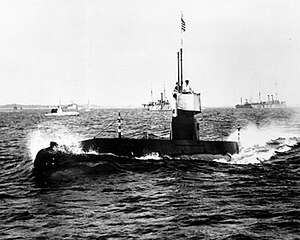 USS C-2 in the Atlantic Ocean sometime between 1912 and 1919. USS C-2 in the Atlantic Ocean sometime between 1912 and 1919.
| |
| History | |
|---|---|
| Name | USS Stingray |
| Builder | |
| Laid down | 4 March 1908 |
| Launched | 8 April 1909 |
| Sponsored by | Ms. Elizabeth Stevens |
| Commissioned | 23 November 1909 |
| Decommissioned | 23 December 1919 |
| Renamed | C-2, 17 November 1911 |
| Stricken | 23 December 1919 |
| Fate | Sold for scrap, 13 April 1920 |
| General characteristics | |
| Class and type | C-class submarine |
| Displacement |
|
| Length | 105 ft 4 in (32.11 m) |
| Beam | 13 ft 11 in (4.24 m) |
| Draft | 10 ft 11 in (3.33 m) |
| Installed power |
|
| Propulsion | |
| Speed |
|
| Range |
|
| Test depth | 200 feet (61.0 m) |
| Complement | 15 officers and enlisted |
| Armament | 2 × 18-inch (450 mm) bow torpedo tubes (4 torpedoes) |
USS C-2 (SS-13) was one of five C-class submarines built for the United States Navy in the first decade of the 20th century.
Description
The C-class submarines were enlarged versions of the preceding B class, the first American submarines with two propeller shafts. They had a length of 105 feet 3 inches (32.1 m) overall, a beam of 13 feet 10 inches (4.2 m) and a mean draft of 10 feet 10 inches (3.3 m). They displaced 240 long tons (240 t) on the surface and 273 long tons (277 t) submerged. The C-class boats had a crew of 1 officer and 14 enlisted men. They had a diving depth of 200 feet (61.0 m).
For surface running, they were powered by two 240-brake-horsepower (179 kW) Craig gasoline engines, each driving one propeller shaft. When submerged each propeller was driven by a 115-horsepower (86 kW) electric motor. They could reach 11 knots (20 km/h; 13 mph) on the surface and 9 knots (17 km/h; 10 mph) underwater. On the surface, the boats had a range of 776 nautical miles (1,437 km; 893 mi) at 8.13 knots (15.06 km/h; 9.36 mph) and 24 nmi (44 km; 28 mi) at 8 knots (15 km/h; 9.2 mph) submerged.
The boats were armed with two 18-inch (450 mm) torpedo tubes in the bow. They carried two reloads, for a total of four torpedoes.
Construction and career

C-2 was laid down by Fore River Shipbuilding Company in Quincy, Massachusetts – under a subcontract from Electric Boat Company – as USS Stingray. She was launched on 8 April 1909 sponsored by Ms. Elizabeth Stevens, and commissioned on 23 November 1909. She was renamed USS C-2 on 17 November 1911. C-2 – assigned to the Atlantic Torpedo Fleet and later the Atlantic Submarine Flotilla – cruised along the East Coast until 20 May 1913, when she cleared Norfolk, Virginia, for six months of operations from Guantánamo Bay, Cuba. In December, she reported at Cristóbal, Colón, Panama, and began an operating schedule of torpedo practice, exploration of anchorages, and harbor defense duty at ports of the Panama Canal Zone. During the latter part of World War I, C-2 patrolled the Florida coast. The submarine was placed in ordinary at Coco Solo, Canal Zone on 22 August 1919, and was decommissioned on 23 December 1919. She was sold for scrap on 13 April 1920.
Notes
References
- Friedman, Norman (1995). U.S. Submarines Through 1945: An Illustrated Design History. Annapolis, Maryland: Naval Institute Press. ISBN 1-55750-263-3.
- Gardiner, Robert & Gray, Randal, eds. (1985). Conway's All the World's Fighting Ships 1906–1921. Annapolis, Maryland: Naval Institute Press. ISBN 0-85177-245-5.
 This article incorporates text from the public domain Dictionary of American Naval Fighting Ships. The entries can be found here and here.
This article incorporates text from the public domain Dictionary of American Naval Fighting Ships. The entries can be found here and here.
External links
- Photo gallery of USS Stingray at NavSource Naval History
| United States C-class submarines | |
|---|---|